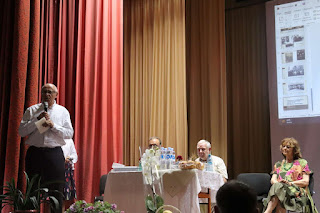  Events Archive Events Archive
International conference “75 years since the second wave of deportations from Bessarabia”
Mereni village, Anenii Noi district, July 5, 2024
On July 5, 2024, in Mereni village, Anenii Noi district, the international conference "75 years since the second wave of deportations from Bessarabia" took place, an event organized by the Association of Former Deportees and Political Detainees from Moldova in partnership with the National Museum of History of Moldova, the Museum of History and Ethnography of Mereni, the Complex of open-air museum in memory of the victims of political repressions, with the support of the Civic Academy Foundation, the Hanns Seidel Foundation - Republic of Moldova, and the Mereni City Hall. The conference brought together about 200 participants, including historians, museographers, lawyers, psychologists, representatives of the public administration, civil society and mass media from the Republic of Moldova and Romania who, together with the inhabitants of Mereni village, honored the memory of those arrested and deported during the Soviet regime of occupation. The event started with a visit to the Complex of open-air museum in memory of the victims of political repressions in the village of Mereni, where, in the presence of the survivors of the Stalinist repressions and deportations from various localities of the Republic of Moldova, the commemoration of those who perished due to the atrocities of the totalitarian-communist regime took place. The proceedings of the conference were inaugurated by the president of the Association of Former Deportees and Political Detainees, Mr. Alexandru Postica, who emphasized the importance of commemorative actions for understanding the past, as well as the need for elaborated memory policies in order to ensure "the effective rehabilitation of victims of repression". On behalf of the National Museum of History of Moldova, the greeting was addressed by the General Director, university professor dr. hab., Eugen Sava, who mentioned the systematic effort undertaken by the National Museum of History of Moldova toward the scientific-museographical valorization of history and memory of the former deportees and political prisoners from the Moldavian SSR period, as well as the openness to cooperation at the national and international level, capable of contributing to building a European memory in the society of the Republic of Moldova. Among the honorific guests at the conference proceedings was Mrs. Ana Blandiana, President of the Romanian Civic Academy Foundation, who reiterated the need to educate the new generations in the spirit of freedom and democracy. During the conference, communications were presented by the following guests: univ. prof., dr. hab. Anatol Petrencu, President of the Association of Historians "Alexandru Moșanu"; acad. Valeriu Pasat, Institute of History, MSU; Mr. Ion Manole, Promo-LEX Executive Director; assoc. prof., dr. Virgiliu Bîrlădeanu, head of the Contemporary History Section, Institute of History, MSU; assoc. prof., dr. hab. Zinaida Bolea, Department of Psychology and Educational Sciences, MSU; Mrs. Niculina Moica, President of the Association of Former Political Detainees from Romania; univ. prof., dr. hab. Gheorghe Postică, National Museum of History of Moldova; Mrs. Maria Seretean, "Emil Nicula" Theoretical High School; Mr. Ion Negrei, scientific researcher, Institute of History, MSU; dr. hab. Cosmin Budeancă, Institute for the Investigation of the Crimes of Communism and the Memory of the Romanian Exile - IICCMER, Bucharest; dr. Denisa Florentina Budeancă, National Council for the Study of Security Archives - CNSAS, Bucharest; dr. Priest Maxim Melinti, Cultural Advisor of the Metropolis of Bessarabia; dr. Maria Gogu-Zinovii, National Archives Agency. The speakers focused on the historical context in which the communist repressions and the Stalinist deportations took place, especially in the village of Mereni, elucidating important aspects regarding historical knowledge, the impact on today's society and the assumption of responsibility not to admit the repetition of such crimes against humanity in the future.
|





 The side panels are elegantly decorated with refined cast-iron elements in the Art Nouveau style, displaying the brand name - "Ideal." The Polyglott model, featuring a bilingual keyboard patented in the United Kingdom by Max Klaczko from Riga, Latvia, was produced between 1902 and 1913, marking the first typewriter capable of writing in two languages. The "Ideal Polyglott" typewriter was actively sold in the Russian Empire and gained significant popularity in Poland, Bulgaria, and Serbia.
The side panels are elegantly decorated with refined cast-iron elements in the Art Nouveau style, displaying the brand name - "Ideal." The Polyglott model, featuring a bilingual keyboard patented in the United Kingdom by Max Klaczko from Riga, Latvia, was produced between 1902 and 1913, marking the first typewriter capable of writing in two languages. The "Ideal Polyglott" typewriter was actively sold in the Russian Empire and gained significant popularity in Poland, Bulgaria, and Serbia.



















































